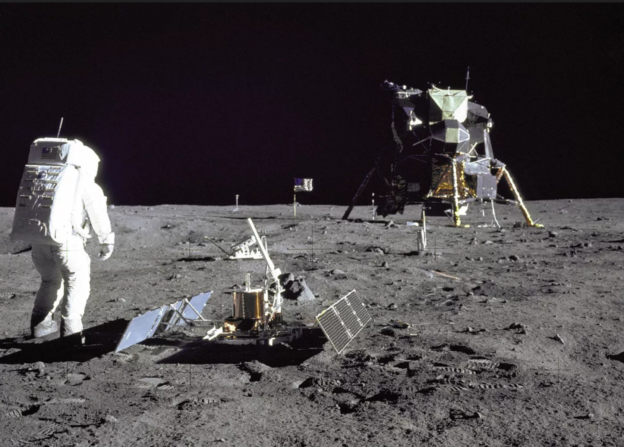The Apollo Guidance Computer (AGC) code facilitated the Moon landing, a feat whose fiftieth anniversary we celebrate this month. As the Moon landing represents the achievement of what that code enabled, my new, co-authored book Moonbit (punctum books, 2019) seeks to highlight what that code said along the way. Moonbit celebrates the way in which we wrote our way to the Moon, in natural language and in machine language. Much of the AGC code commentary contains interesting and even radical speech acts. Humor reads as resistance. Scatological jokes riff on cleaning products and enemas. Appeals are made. Current events are written into the fabric of the code. Cultural signs are embedded in the commentary. The code did what it was written to do yet it is still speaking to readers in the present.
Much of what my co-author and I found remarkable in the AGC code did not make the translation to the core rope memory, and stayed stuck in the printed paper copies of the code, until the code was uploaded to the GitHub repository in July of 2016. Moonbit is our attempt to give new life to this historically significant code and present it to a modern audience using poetic and critical interventions.
As soon as I laid eyes on this code, it was clear to me that I needed to make erasure poetry using the AGC code as a source text. I started pulling out phrases that had particularly poetic resonances. Erasure poetry is an OULIPO practice in which poems are carved from some other text. OULIPO has a rich history of scientific and mathematical intersections. I attempted to make certain otherwise “hidden” aspects and dimensions within the code hyper-visible by erasing much of the code. Code-derived erasure poetry gives us the opportunity to make meaningful signal from purely functional noise.
The AGC code exists as an original source, something we have access to that remains exactly as it was fifty years ago. As an art historian might look at paintings from a period in history as a primary source worthy of a certain kind of study, so we must look at the AGC code. People have changed. Technological interfaces have changed. The relationships people have with technologies are vastly different. We know that code is more than just a technological tool. People leave traces of themselves in everything they do. When researching this book, I learned about Margaret Hamilton, the lead software developer for the AGC and one of the first people to hold the position of what we now call a software engineer. I also learned about the many women who translated the stored instructions from computer-created wiring diagrams into the miles of twisted ropes that provided materially manifested these instructions. In teasing out and analyzing the traces of these people and the culture in which they worked, I believe Moonbit adds something new to the larger conversation, and suggests ways we might consider looking at code that is being written now.
Have you taken a look at Apollo Guidance Computer code? If you haven’t seen this code yet, treat yourself. July 20, 2019 marks the fiftieth anniversary of the Moon landing. Many books are coming out now that will suggest new ways of thinking about Apollo 11 but many repeat the triumphal top-down masculine narratives of Cold War technoscience. Moonbit listens to the Apollo Guidance Computer code, and translates it into poetry, allowing the code itself to sing.
–Rena J. Mosteirin is the co-author of Moonbit (punctum books) an academic and poetic exploration of the Apollo 11 guidance computer code. Her novella Nick Trail’s Thumb won the Kore Press Short Fiction Award, judged by Lydia Davis, and a chapbook of her Moby-Dick erasure poetry called half-fabulous whales, is coming soon from Little Dipper. She is an editor at Bloodroot Literary Magazine, holds an MFA from the Bennington Writing Seminars, and teaches creative writing at Dartmouth College.

One response to “Making Apollo Guidance Computer Code-Based Erasure Poetry”
I want to first mention I find the idea of modifying code into poetry to be a beautiful one. I have also engaged in makingwork that attempts to make poetry from code. I do however keep to the formaliites of code and wonder if I can still make it function. I want to try to ask the question, what does it mean when code executes a command? So what happens when you erase parts of code, where all parts are necessary to still be the actual code. Are you actually modify code or are you taking a gathering of words that used to be code and shifting them into something new? If it is building something new can you still call the object code? I certainly do not have the correct answer but I think these questions are important to ask when creating media for the public to the consumer. Should we label things inaccurately? Who does that affect and why/how?